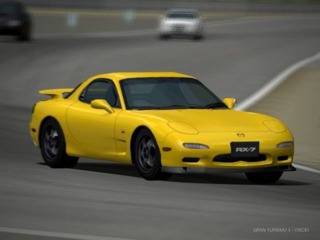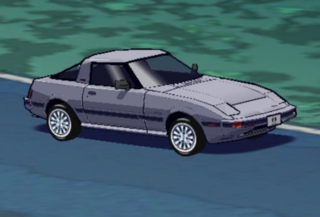Overview
 2000 Mazda RX-7 FD, as seen in Gran Turismo 4
2000 Mazda RX-7 FD, as seen in Gran Turismo 4The Mazda RX-7 is a sports car that was in production from 1978 to 2002. The RX-7 was famed for its rotary Wankel engine (A type of engine that uses a rotating motion to create energy as opposed to pistons) and outstanding performance. The RX-7 went through an extensive amount of revisions and three major generations, which ended at the FD (3rd) generation in 2002.
Featured in an incredible amount of games and other forms of entertainment and media, such as being immortalized in the Initial D series as Keisuke's race car, the RX-7 is a hallmark of Japanese sports car design. It was a prominent showcase of Japanese motorsport and continues to be one of the most popular cars of the import/tuner scene.
The Mazda RX-7 led a strong, 34-year legacy that encompassed critical praise, awards and commendations like few other cars in history. Considered to be one of the most balanced, fun-to-drive and powerful Front-Mid Engine cars, the RX-7 ended its long production run with 811,634 models produced and was succeeded by the Mazda RX-8.
In October 2012, whilst unveiling the Mazda MX-5 relaunch at the annual SEMA show, Mazda sports car chief Nobuhiro Yamamoto announced that the RX-7 will return to manufacturing as of 2015 with "less weight, less complexity and a greater emphasis on driver involvement."
History
First Generation (FB)
 The Mazda RX-7 FB, as seen in Auto Modellista
The Mazda RX-7 FB, as seen in Auto ModellistaThe first generation of RX-7s officially went into production in 1979. The FB models saw three separate revisions (Series I, II and III), of which the second was the model that adopted the "FB" name. The first and second revisions saw only minor mechanical and cosmetic changes. The third revision would see engine improvements, as well as changes to the instrumentation and suspension for the North American market.
The FB models ceased production in 1985 and was acclaimed throughout its production for the quality of build, excellent suspension and mechanical performance as well as its, at the time, blisteringly fast acceleration.
Second Generation (FC)
 Mazda RX-7 FC (S4), as seen in Gran Turismo 5
Mazda RX-7 FC (S4), as seen in Gran Turismo 5The second generation of RX-7s, known in Japan as the Savanna RX-7, started production in 1986 with the Series 4 and continued in 1989 with the Series 5. The FC would see a complete overhaul in both mechanical and cosmetic features of the growingly popular RX-7.
 Mazda RX-7 FC (S5), as seen in Forza Motorsport 3
Mazda RX-7 FC (S5), as seen in Forza Motorsport 3Designed after the Porsche 944 due to its popularity in the North American market (where the majority of FB models were sold), Mazda would bring several improvements to the RX-7 to bridge the gap between a sports and touring car. Mazda introduced rack and pinion sterring, standard disc brakes and an optional turbocharged engine, which would be released as a separate model in North America called the "Turbo II". The FC was also the first car to see the introduction of Mazda's Independant Rear Suspension system-- an improvement that would almost eliminate common oversteer issues with the FB.
Like its predecessor, the FC was incredibly well-received by press and consumers, winning several awards and gaining a firm standing in the import market of the early 90's. Japanese restrictions on turbocharged cars would unfortunately limit sales of the car in Japan, however, further growing its stronger dominance in the North American market.
Third Generation (FD)
 Mazda RX-7 FD, as seen in Gran Turismo 4
Mazda RX-7 FD, as seen in Gran Turismo 4The FD, also known in Japan as the Ẽfini RX-7, is the third and final generation of the Mazda RX-7. It began production in 1992 and saw three major revisions, starting with the Series 6. The FD was the first to introduce a sequential twin-turbocharged engine in the import market and the Series 6 "R-tuned" model offered in North America included improved suspension, Z-rated tires and an aerodynamics package. The Series 7, in production from 1996 to 1998, saw only minor changes to the turbocharger for increased output power.
The Series 8, in production from 1999 to 2002, was the final model of the RX-7 and was only sold in the Japanese market. Its appearance remained the same but the S8 saw a multitude of performance improvements that were offered through a variety of limited edition models, some of which still fetch an exorbitantly high price. The intercooler, radiator and turbocharger were all improved, as were the brakes, front lights, rear lights and rear spoiler. The Type RS and RZ models also offered aftermarket suspension and cosmetic upgrades as options. The rarest of all models, however, were the Spirit R editions with only 1,500 models built. They featured every improvement, option and upgrade from the FD's history alongside new features.
The Mazda RX-7 continues to be held as one of the greatest sports cars ever built and still holds an incredibly strong relevance in car culture thanks to the import scene. Garnering an unparalleled amount of awards and praise, the RX-7 gained a secure spot in automotive history and, in both games and real lift, will undoubtedly continue to shine as an example of Mazda's finest automotive engineering.
In Video Games
 Mazda RX-7 FB, as seen in Test Drive
Mazda RX-7 FB, as seen in Test DriveThe Mazda RX-7's first video game appearance was in Test Drive, a DOS (and multiple other platforms) game released in 1987. It was a non-player controlled vehicle that would appear in traffic on occasion. Appearances were slightly spotty in games from then-on, appearing next 6 years later in Burning Rubber for the Amiga.
 Mazda RX-7 FD, as seen in The Need for Speed
Mazda RX-7 FD, as seen in The Need for SpeedThe car's first major appearance was in 1994's Road & Track Presents: The Need for Speed, where it was featured for the first time as a player-controlled vehicle. This would mark the start of the RX-7's populous presence in driving games, being featured in several drift-based, Japanese racing games for the next few years.
However, the real introduction would come four years later in 1998, where both the FC and FD would appear in Gran Turismo, the incredibly popular driving simulator for the PlayStation that would go a very long way to making a laundry list of cars a common name within the minds of gamers. A year later, the FB, FC and FD models would all make a re-appearance in the game's sequel, Gran Turismo 2.
 Mazda RX-7 FD Type RZ, as seen in Gran Turismo 3
Mazda RX-7 FD Type RZ, as seen in Gran Turismo 3The notable appearance in what was, at the time, the most popular racing game on the market made the Mazda RX-7 a linchpin in racing games of that era, being heavily featured in the multitude of racing games to be released in years after, such as Sega GT, Driving Emotion Type-S and Tokyo Xtreme Racer. In 2001, the car would again make its re-appearance in the ever-growing popular Gran Turismo series with Gran Turismo 3: A-Spec. Thanks to the increased car list, Polyphony Digital used this opportunity to begin including the variations of the RX-7 models, such as the Type RZ, which would usually including minor performance changes. A somewhat meaningless change to the game, but a big one for car aficionados.
Appearances would continue in games throughout the next few years in sequels to racing games. 2003, however, would be the landmark year for the RX-7, being featured in Need for Speed: Underground as one of the premier cars of the game. The import tuner culture explosion of the early 2000s would pave the way for the RX-7's importance presence in tuner games, such as the rest of the Need for Speed series, Street Racing Syndicate and the Midnight Club series.
Thanks to simulation games, arcade games and the import scene's popularity, the RX-7 quickly became one of the most popular cars in driving games, and continues to be so today in games such as Need for Speed: The Run and Forza Motorsport.
It may be out of production, but the legacy, praise and admiration for Mazda's most popular sports car will without a doubt continue to live on in video games, with avid racing fans there to enjoy every corner and straightaway in the seat of its landmark history.
Log in to comment